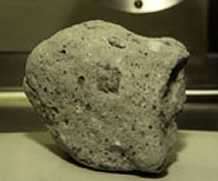Tää oli uutta tietoa mulle. Aikamoista sanoisin.
Moon Rock Turns Out to be Fake
by Lin Edwards

Astronauts who landed on the Moon collected 2,415 samples of Moon rocks weighing a total of 842 pounds (382 kilograms). Most of these rocks were collected during the Apollo 15, 16, and 17 missions. Image Credit: NASA
(PhysOrg.com) -- The Dutch national Rijksmuseum made an embarrassing announcement last week that one of its most loved possessions, a moon rock, is a fake -- just an old piece of petrified wood that's never been anywhere near the moon.
The Rijksmuseum is famous for its fine art collections, especially paintings by Rembrandt and other masters. One of its lesser known objects, the "moon rock", was first unveiled in October 2006 as the centerpiece of a "Fly me to the moon" exhibition. At that time, the museum said the rock symbolized the "exploration of the unknown, colonization of far-away places and bringing back of treasures..." A reading about the "moon rock" was even held on October 7 because it was a full moon!
The rock was given as a private gift to former prime minister Willem Drees Jr in 1969 by the U.S. ambassador to The Netherlands, J. William Middendorf II, during a visit by the
Apollo 11 astronauts, Armstrong, Collins and Aldrin, soon after the first
moon landing. Drees had been out of office for 11 years, but was considered an elder statesman.
When Drees died in 1988, the rock was donated to the Rijksmuseum, where it has remained ever since. According to a museum spokeswoman, Ms Van Gelder, no one doubted the authenticity of the rock because it was in the prime minister's own collection, and they had vetted the acquisition by a phone call to NASA.
According to an article published by the Rijksmuseum, at one time the rock was insured for approximately half a million dollars, but its actual value is probably no more than around $70.
Former U.S. ambassador, Mr Middendorf was unable to recall the exact details of how the rock came to be in the U.S. State Department's possession. It is known that
NASA gave lunar rocks to over 100 countries in the 1970s, but when the rock was displayed in 2006 a space expert told the museum he doubted any material would have been given away so soon after the manned lunar landing.
Researchers from the Free University of Amsterdam immediately doubted the rock was from the moon, and began extensive testing. The tests concluded the rock was petrified wood. U.S. embassy officials were unable to explain the findings, but are investigating.
Even though the tests found the piece is not of lunar origin, the Rijksmuseum curators say they will keep it anyway as a curiosity.
© 2009 PhysOrg.com



